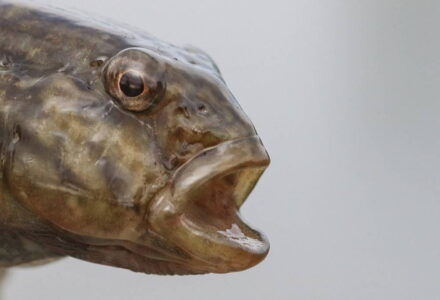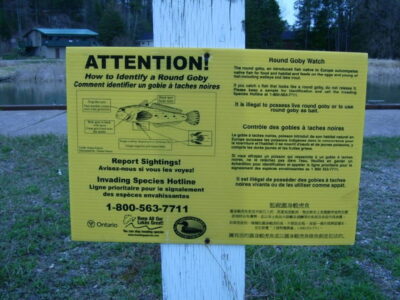Outswimming Extinction in the Great Lakes

Dan Egan, The Death and Life of the Great Lakes (W.W. Norton, 2017)
 Growing up near the vast expanse of the Atlantic Ocean, solaced by the sound of waves upon the shore and the tang of salt marshes, I never dreamed that I would spend the rest of my life landlocked near the Great Lakes. After a childhood spent eating fish that I caught myself—flounder, herring, blowfish (we only ate their tails)—who would have thought I would end up feasting upon lake trout and whitefish from the Great Lakes? But we moved from job to job further and further inland, until I found myself a Great Lakes rather than an ocean dweller.
Growing up near the vast expanse of the Atlantic Ocean, solaced by the sound of waves upon the shore and the tang of salt marshes, I never dreamed that I would spend the rest of my life landlocked near the Great Lakes. After a childhood spent eating fish that I caught myself—flounder, herring, blowfish (we only ate their tails)—who would have thought I would end up feasting upon lake trout and whitefish from the Great Lakes? But we moved from job to job further and further inland, until I found myself a Great Lakes rather than an ocean dweller.
I have always known more about salt than fresh water species, and I witnessed the die-off of alewives in the 1960s and salmon spawning in front of my Betsie River cabin in the late 1990s with considerable puzzlement. My lack of familiarity with lake ecology made Dan Egan’s history of Great Lakes fishes particularly interesting.
Lately, chilled by all the talk of how climate change is depleting species, I have been cheered by news of sudden adaptations. Isn’t evolution a long, drawn-out process, requiring thousands of years of mutation for a species to accommodate new conditions in its ecosystem? Maybe not. In Dan Egan’s account of how native Great Lakes fish have responded to invasive species after the opening of the St. Lawrence Seaway in 1959, changes happen much more quickly than that.
One Crisis after Another
Until the St. Lawrence Seaway linked the Atlantic Ocean to the Great Lakes with its dams, canals, and locks, the Midwestern inland seas constituted a landlocked, fresh water ecosystem rich with indigenous species like lake trout, whitefish, perch, and chub.
The first invasive species to impact these fish stocks was the vampiric sea lamprey. It worked its way up the St. Lawrence Seaway system to decimate native species by clamping suctioned mouths to the bigger fishes’ bellies and vacuuming their guts out. A concerted scientific search for a solution that could destroy lamprey without harming nearby fish led to the discovery and application of an effective toxin.

A vampiric lamprey suctions onto the glass of an underwater camera dome. Photo by Dave Herasimtschuk.
In his detailing of subsequent events, Egan draws upon his reportorial skills to engage his readers as one crisis after another unfolds within the complicatedly interactive web of the fresh water ecosystem. Before the lamprey were controlled, they decimated larger species like the lake trout, so when Atlantic river herring—locally dubbed “alewives”—invaded in the 1960s, there were not enough predator fish left to control them.
As he chronicles historical developments from the building of the St. Lawrence Seaway to the present-day danger of invasive carp, Egan fills us in with the full story of each species’ role in a constantly changing ecosystem. With alewives abundant and native fish too depleted to compete, coho and chinook salmon were introduced to draw in sport fisherman and tourists on charter boats. The alewives, heavily preyed upon by the new salmon species, did not remain plentiful. Moreover, the alewives’ kidneys worked better in their native salt water than in fresh water and they couldn’t tolerate the Great Lakes’ sudden plunges into cold temperatures. Compounding the alewives’ troubles, when zebra and quagga mussels were dumped into the Great Lakes in the ballast from commercial ships, they gorged on the plankton that were alewives’ principle diet.

Zebra mussels cover a shopping cart. Photo by James F. Lubner, University of Wisconsin Sea Grant Institute.
What Seemed Inevitable Wasn’t
The alewives were not the only species impacted by the mussel invasion, which brings me back to the Great Lakes whitefish. Whitefish feed on little shrimp-like creatures on the lake bottom, which also depend upon the plankton depleted by the invasive mussels. Whitefish were toothless and only fed on soft food; it seemed inevitable that they would starve to death.
Except that they didn’t. “But then nature stepped in,” explains Egan. Biologists examining whitefish digestive systems found “a paste of crushed mussel shell” in their excrement. They suffered, at first, from what could be described as an excruciatingly painful variety of fish hemorrhoids. But then, in a split second of evolutionary time, they developed a “stiff ridge on their bellies” to digest the tough shells.
The whitefish had competition from invasive bottom feeders called gobies, with round mouths ringed with razor sharp teeth to crack mussel shells open. So these whitefish, after a spell of lacerated mouths and faces, developed teeth to feast upon the gobies. Nor were they the only beneficiaries: “The recovery of the native stocks on Lake Huron,” writes Egan, “has been bolstered by their ability to feast on bottom-dwelling gobies. . . . Native walleye are feasting on gobies, as are smallmouth bass, perch, and brown trout.”
Witnessing Evolution Firsthand
Egan brings in the voices of people living and working closely alongside the fish to help explain what is so remarkable about their changing habits. Ken Koren, a traditional Great Lakes fisherman and one of the first to report these developments, felt like he was “watching evolution at work.” A Lake Huron fisherman named Hendrickson, similarly, was “absolutely convinced the species [was] evolving before his eyes.” “What we’re seeing with the whitefish,” he mused, “well, they might be the most adaptable fish in nature. … They’re more adaptable than some people I know.”

Italian wall lizards, new denizens of New York City. Photo by Gennaro Fusco.
Other creatures, I have discovered, have experienced similarly sudden adaptations to global warming. Snowshoe hares are developing thinner winter coats and in their southernmost range are discarding their winter coloration altogether. House finches’ beaks have changed shape to be more useful for cracking bird feeder seeds, and male finches dwelling in cities now compose louder songs to be heard over urban noises. Italian wall lizards are popping up all over New York City, escapees from pet stores once native to balmy Tuscany. These lizards discovered that railroad tracks leading from the city are warmed by train traffic and now head north along the Hudson river to further expand their range.
One lesson readers can learn from The Death and Life of the Great Lakes is not to be afraid of invasion and change, but to embrace it as necessary for survival. But I am left with the question of whether Homo sapiens, with our supposedly superior cognition, can come up with solutions to climate change before we and other species vanish from the face of the earth. Or, as Pogo, finding himself surrounded by trash in his bayou on Walt Kelly’s memorable poster for the first Earth Day, puts it: “We have met the enemy, and he is us.”
Featured image: Algal blooms on Lake Erie, August 14, 2017. Photo by Zachary Haslick, Aerial Associates Photography, Inc., as part of the NOAA Great Lakes Harmful Algal Blooms and Hypoxia program.
Annis Pratt was a Professor of English and a founding mother of Women’s Studies at the University of Wisconsin-Madison, and has developed her second career as an ecofiction novelist and environmental activist in Michigan. She has written several books of literary criticism, including Dylan Thomas’ Early Prose: A Study in Creative Mythology (Pittsburgh University Press, 1970), Archetypal Patterns in Women’s Fiction (Indiana University Press, 1981), and Dancing With Goddesses: Archetypes, Poetry and Empowerment (Indiana University Press, 1994), as well as a four volume series of ecofiction novels based on the draining of the East Anglian Fens, The Marshlanders, Fly Out of the Darkness, The Road to Beaver Mill, and The Battle for the Black Fen. Pratt is also a columnist at Impakter magazine and a member of the Citizens’ Climate Lobby. Website. Twitter. Contact.


Annis, I hadn’t realized you were such a great and active environmentalist! This is a terrific article summarizing the essential theses of “The Death and Life of The Great Lakes” which I read only in part and then gave as a July bbirthday present to Ryan, my great nephew, who is trying to get an environmental club going in his high school. Think I’ll print out your article and send it on to him as he’s so involved in local theater that he probably hasn’t had time to read the book. Not to mention that he, his parents (my nephew Nat and wife Karen) and younger brother Justin are all headed to Barcelona and Valencia for 2 wks at Christmas to meet up with older brother Jared who is spending gap year in Spain before heading to Brown for college next fall.
Anyway, I am almost as impressed by your article as I was originally by Egan’s landmark book! Go, Annis!